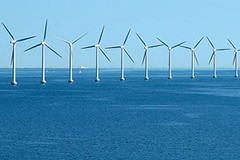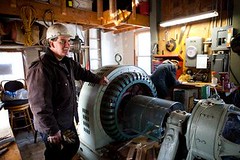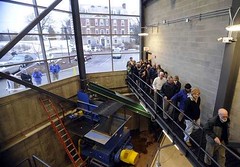"In the absence of dramatic changes in human behavior relative to Earth's natural systems, gradual population shrinkage, an end to overconsumption by the rich and a redistribution of wealth and opportunity, it is likely the natural system will react in ways that will reduce the scale of the human system in a very unpleasant manner. Debt and employment problems can be solved entirely by negotiation; one cannot negotiate with nature."Among the groups mentioned in his talk that are attempting to move along a more sustainable path: Occupy Wall Street, Global Movement to Solve the Climate Crisis, GrowthBusters and MAHB: Millennium Alliance for Humanity and the Biosphere.
A roving compendium of ecocentric energy options, including advances in solar and wind power, hybrid vehicles, and other thoughtful, balanced approaches to renewable energy.
Monday, December 10, 2012
The Greatest Crisis Faced by Humans
Sunday, November 18, 2012
Realistic Solutions for Combatting Climate Change
Friday, April 13, 2012
A Community Breaks Away from Coal
Dissatisfied with the direction of the utility company supplying their energy, citizens of Boulder, CO took matters into their own hands and passed ballot measures to create their own municipal power utility. As written in Yes Magazine:
The city’s current electricity supplier, Xcel Energy, is a large corporation that sources more than 60 percent of its power from coal. Colorado climate activists tried for years to persuade Xcel to transition from coal to renewables, arguing that the state’s plains, mountains, and 300 days of annual sunshine give it abundant potential for the development of wind and solar power. But they found Xcel’s take-up of renewables was frustratingly slow. Xcel is investing $400 million in its coal-powered plants, and its plans for renewables stops at just 30 percent in 2020, with no further increase until 2028.
If more communities follow this example, we might even become effective tackling global warming while demonstrating the power of genuine democracy in action.
Thursday, November 24, 2011
Almost as smart as termites

We know that ground-nesting termites can build mounds where the temperature and humidity remain moderate year round (a concept that has drawn the attention of architects in recent years). But, for whatever reason, humans don't typically pay much attention to natural heating and cooling in their building design and construction—a fact that leads to an enormous amount of energy consumption so that building inhabitants don't suffer from the heat or cold.
You can find exceptions to this tendency to ignore trees, shade, hillsides, and sun exposure when constructing buildings, even back in the 19th century. One good example, highlighted in Julia Whitty's Blue Marble blog (the post is a couple of years old, but as relevant today as when it was written), is Lincoln's cottage, where the President escaped the suffocating climate of Washington D.C. in the summer.
Among the passive techniques that characterize the cottage:
The builders relied on smarts not watts. Some of their techniques included:
Orienting the building so a powerful crossbreeze blows when the front door and rear windows are opened
Installing tall windows with two sections, a top half to expel warm air and a bottom half to introduce it
Attaching shutters to block the sun or let light in when necessary
Decorating with lace curtains to minimize bugs not breezes
Some of the simplest techniques available could make an enormous difference in energy consumption in our homes and cities. It's not too late to learn from the termites and the builders of the 19th century.
Wednesday, November 17, 2010
Climate change deniers take over the House

Hopenhagen
Originally uploaded by Bjørn Giesenbauer
Elizabeth Kolbert's Field Notes from a Catastrophe tackled the challenge of global warming as a first-person observer, traveling around the world to witness the changes in places where they are most severe. Now, writing for The New Yorker in Uncomfortable Climate, she takes a hard look at the current crop of deniers entering the US House of Representatives, many of whom consider their primary role as disrupting any hope of political progress on this critically important global problem.
Though four presidents in succession have paid lip service to preventing dangerous climate change, these commitments haven't lead to any significant action given the magnitude of the challenge.
Elizabeth sums up the current situation neatly:
Meanwhile, as John Boehner chortles about the dangers of CO2, the world keeps heating up. According to the National Oceanic and Atmospheric Administration, the first half of 2010 was the warmest January to July on record. And this is just the beginning. Owing to the inertia of the climate system, the warming that we’re experiencing is only a fraction of the temperature increase that’s already guaranteed.
The United States is no longer the world’s largest carbon emitter; that honor belongs to China. But we’re still the largest source of warming in terms of cumulative emissions, and on a per-capita basis Americans produce more CO2 than just about anyone except the Qataris. Without the active support of the United States, there’s no way to make progress on emissions globally. This month, negotiators will meet in Cancún for another round of international climate talks, and it’s a safe bet that, apart from the usual expressions of despair, nothing will come of them. It may seem that we’ll just keep going around and around on climate change forever. Unfortunately, that’s not the case: one day, perhaps not very long from now, the situation will spin out of our control.
The window left for action is closing quickly. If the new members of the House have their way, it will be slammed shut permanently, in blithe ignorance of the consequences.
Saturday, January 16, 2010
Jellyfish Populations and Global Warming

false twins -jellyfishes
Originally uploaded by marfis75
"They just make these things up," climate modeler Mojib Latif observed after seeing an article in the London Daily Mail that identified Latif as projecting a 30-year span of global cooling. This Truthout article, written by Michael Winship, offers other examples of climate change deniers misinterpreting and misrepresenting scientific studies, often attributing statements to researchers that are essentially bald lies.
In fact, as Latif told the British newspaper the Guardian, "I believe in manmade global warming... There is no doubt within the scientific community that we are affecting the climate, that the climate is changing and responding to our emissions of greenhouse gases."
Winship than points to one of the bizarre and harrowing consequences of global warming: massive increases in jellyfish populations that are causing havoc with the fishing industry and jamming desalination plants.
This has led to all manner of consequences, some you would expect, others not. A 2008 National Science Foundation study found populations growing along the East Coast -- in the Chesapeake Bay area, people are stung about half a million times a year. In the Middle East and Africa, swarms have jammed hydroelectric and desalination plants, forcing them to shut down. In Japan, the fishing industry is losing up to $332 million a year because jellyfish swarms fill the nets, crowding out mackerel, sea bass and other fish.
The AP reports that in October, off the eastern coast of Japan, "Jelly-filled nets capsized a 10-ton trawler as its crew tried to pull them up. The three fishermen were rescued."
This is the stuff of science fiction, but in this case it's entirely real.
Wednesday, January 06, 2010
Derailing Wind Energy Progress

The basis of our American experiment in democracy has always been predicated on following the will of the majority while respecting the positions of the minority. As a recent Mother Jones article (Cape Wind Delay a Big Win for Dirty Energy Interests) points out, the democractic process has been turned on its ear by an unlikely alliance of oil and gas interests with a group of Native Americans who are looking to define an entire body of water as a national historic site, blocking the construction of the Cape Wind Project on Nanucket Sound.
Journalist Kate Sheppard notes:
The tribes surely have perfectly sound reasons of their own for opposing the project. "We are hoping...that we can protect the sound and our religious right to worship the rising sun and be able to pass that tradition on to our grandchildren," Green said. "The government has not honored many of the things it has promised to the Native American people...All we have is the process, and all we've asked for is due process."
That's clearly a consideration for the Department of Interior, which oversees NPS. To that end, the Interior Department recently issued a new tribal consultation policy, a long overdue effort to improve the agency's relationship with tribes.
But in the case of this particular decision on Cape Wind, granting this level of preservation to an entire body of water could be a bad omen for all future offshore wind development. Barring development here, Cape Wind president Jim Gordon told Mother Jones recently, "would have a chilling effect on what could possibly be one of the most promising sources for energy independence and creating a new green economy."
The forces aligned against renewable energy use every tactic imagineable to derail progress on the alternative energy front. In this case, the majority of the residents of Massachusetts, the state legislature, the state's congressional delegation, and the Governor, Deval Patrick, are solidly behind the Cape Wind project. The opposition is small, well-funded, and determined--undettered by what their opposition means to the future of energy development or the absolute necessity to reverse global warming. In this particular scenario, democracy isn't working very well at all.
Saturday, January 02, 2010
Stopping Major Climate Distruption

In his new book, Storms of My Grandchildren, climate scientist James Hansen offers a pragmatic solution, perhaps our last chance, for reversing the build-up of CO2 in the atmosphere and restoring equilibrium to global weather patterns. In an excerpt published in The Nation, Hansen spells out the essential tenets of his plan:
Let's define what a workable backbone and framework should look like. The essential backbone is a rising price on carbon applied at the source (the mine, wellhead, or port of entry), such that it would affect all activities that use fossil fuels, directly or indirectly.
Our goal is a global phaseout of fossil fuel carbon dioxide emissions. We have shown, quantitatively, that the only practical way to achieve an acceptable carbon dioxide level is to disallow the use of coal and unconventional fossil fuels (such as tar sands and oil shale) unless the resulting carbon is captured and stored. We realize that remaining, readily available pools of oil and gas will be used during the transition to a post-fossil-fuel world. But a rising carbon price surely will make it economically senseless to go after every last drop of oil and gas--even though use of those fuels with carbon capture and storage may be technically feasible and permissible.
Global phaseout of fossil fuel carbon dioxide emissions is a stringent requirement. Proposed government policies, consisting of an improved Kyoto Protocol approach with more ambitious targets, do not have a prayer of achieving that result. Our governments are deceiving us, and perhaps conveniently deceiving themselves, when they say that it is possible to reduce emissions 80 percent by 2050 with such an approach.
Hansen then goes into a discussion about why cap-and-trade solutions are doomed to failure and what our best bets are for preserving the planet for our grandchildren. As arguably the foremost authority on the issue of global warming, Hansen's words carry a strong degree of credibility.
Monday, October 19, 2009
Climate distruption hits Peru
Wednesday, July 29, 2009
Cooling the Planet with White Roofs

Some energy solutions are complicated. Others are amazingly simple. Among the simplest is a trend that has developed in California to use heat reflective properties of white surfaces to save energy. Homeowners and businesses are installing roof coverings made of a shiny plasticized material that can reduce air-conditioning costs by 20 percent or more during sunny weather, as reported by Felecity Barringer in a New York Times article, White Roofs Catch On as Energy Cost Cutters.
As shown in the photo (by J. Emilio Flores), a Chino, CA discount store relies on a combination of solar panels and white roof covering to minimize energy requirements.
This approach is validated by historical precedents dating back centuries.
The physics behind cool roofs is simple. Solar energy delivers both light and heat, and the heat from sunlight is readily absorbed by dark colors. (An asphalt roof in New York can rise to 180 degrees on a hot summer day.) Lighter colors, however, reflect back a sizable fraction of the radiation, helping to keep a building — and, more broadly, the city and Earth — cooler. They also re-emit some of the heat they absorb.
Unlike high-technology solutions to reducing energy use, like light-emitting diodes in lamp fixtures, white roofs have a long and humble history. Houses in hot climates have been whitewashed for centuries.
It's going to take a multitude of techniques, as well as substantial lifestyle changes, to cope with climate disruption threats, but something as simple as a white roof isn't a bad place to get started.
Tuesday, May 12, 2009
Microgeneration by Hydropower

New England mill towns have a long history of tapping into the power of water running downhill. In the Orion Magazine article, The Poetry of Power, Ginger Strand profiles the resurgence of hydro sites in the area and the role of Verne Tower and others in restoring facilities that have crumbled from neglect.
The tradeoff, of course, is the environmental damage caused by dams--both large and small--and the costs associated with mitigating that damage.
Cost is a highly rational way to make decisions. Big dams may not be ideal, but they’re efficient. Small dams do less harm, but their economic benefits may not outweigh the harm they do. One thing this assumes, of course, is that there’s no relationship between our centralized power grid and our profligate use of power. But it isn’t easy to connect the action of running your microwave to the burning of a hunk of coal two counties away. In the era of Big Energy, power has retreated from the public eye.
People who go off the grid learn to re-see it; when you’re making your own watts, turning on a light or a television has a tangible cost. Heatless Mondays become something to consider. Maybe TV-less Tuesdays too. Recently, when avalanches took out transmission towers that brought hydropower to Juneau, Alaska, the city was forced to run on diesel generators. The price of electricity increased from eleven cents a kilowatt-hour to fifty-three. Within weeks, consumption dropped by 30 percent. But it may not have been just about price. The hydropower plant was nearly thirty miles away; the diesel generators were all within the city limits. And they were dirty. By the time the transmission towers were repaired, the generators had pushed Juneau to the limit of its air-quality permit. Power use was suddenly a cause with effects you could see.
The realities of coping with difficult energy tradeoffs are inescapable as the pressures of global warming force us to rethink the traditional models of power generation. Microgeneration--deriving power from thousands of small sites rather than distributing it from a large site--is a model that has become one of the fastest growing alternative energy options.
Lori Barg, founder of the Vermont Small Hydro Association, commented:
“We’re losing one or two times as much power as we’re using in the end,” Lori says. “If you want to start looking at the economics, is a kilowatt-hour generated in Boston the same as a kilowatt-hour generated in Peterborough, when you have so many losses along the way? It’s like having a leaky bucket.”
A theme runs through the article--reconnecting people to the sources of their power. It's certainly an idea that merits consideration as we look to the sun, wind, and water to meet our power needs.
Friday, March 27, 2009
Middlebury College Becoming Carbon Neutral

With a target to achieve carbon neutral operations by 2016, Middlebury College in Vermont has taken a major first step in that direction with the completion of a $12 million dollar biomass boiler and plant. Bill McKibben, whose organization 350.org is playing a major role in calling for a fair global climate treaty, participated in the opening ceremonies and gave a lecture on the importance of reducing greenhouse gas emissions/
At optimal capacity, which the plant is expected to reach over the next month, the facility will consume about three tons of wood chips an hour and meet about half the campus’s heating, cooling and hot-water needs. The other half will still be supplied by boilers that burn No. 6 fuel oil, but the overall campus use of such oil will be cut in half, from 2 million gallons a year to 1 million. As a result, the college’s carbon dioxide emissions will be reduced about 40 percent, or 12,500 metric tons a year.
Middlebury College is working to develop its own supply and wood chips on its surrounding property and also investigating the potential of geothermal energy for further reducing carbon emissions. More details are available in this article, orginally published in the Burlington Free Press.
Saturday, March 07, 2009
Students Protest Coal on Capitol Hill
Sunday, March 01, 2009
Beyond the Stimulus: A Global Green Deal

With indications that global warming is accelerating faster than many earlier computer models predicted, you would think that this information would spur a concerted global effort to reverse the trend. But so far the response of most governments around the world has been fairly tepid and the levels of greenhouse gas emissions continue to rise in those countries most responsible for the problem.
In a recent article for The Nation, A Global Green Deal, Mark Hertsgaard makes a case for a massive program of green investment to lift people out of poverty, stimulate the worldwide economy, and reduce greenhouse gas emissions.
Hertsgaard believes the Obama's stimulus package is a good start, but more most be done to contend with the problem.
The stimulus package is a good start. It contains $71 billion in direct green spending and $20 billion in green tax incentives, according to an analysis by the Center for American Progress. The World Resources Institute has calculated that every $1 billion in green spending generates approximately 30,000 jobs, so the green portions of the stimulus package should create about 2 million jobs, many in the construction sector, which has been hit especially hard. Retrofitting buildings, installing solar panels and constructing wind farms require skilled and semiskilled labor and create decent-paying jobs that cannot be outsourced. Investing in climate-friendly development in poor countries, where money buys more, should yield even more jobs and economic uplift--no small consideration, given the recent warning from the US director of national intelligence, retired Adm. Dennis Blair, that the economic downturn could become the gravest threat to international stability if it triggers a return to the "violent extremism" of the 1930s.
But even more will have to be done, at home and abroad, if we are to slash emissions quickly enough to preserve a livable planet. President Obama has promised to reduce US emissions to 1990 levels by 2020 and to 80 percent below 1990 levels by 2050. This sounds impressive compared with the Bush/Cheney years, but precisely because of Bush-era foot-dragging, the United States and the rest of the world need to achieve larger and faster emissions reductions than previously assumed. We have "a very short window of time," Rajendra Pachauri, chair of the Intergovernmental Panel on Climate Change, said in January at a Worldwatch Institute conference. If we want to avoid such scenarios as twenty feet of sea-level rise, which would put most of the world's big cities under water, the rise in global temperatures must be limited to 2.0 to 2.4 Celsius above preindustrial levels. That means global emissions must peak by 2015 and then fall rapidly for decades, said Pachauri. In this context, he added, Obama's goal "falls short of the response needed by world leaders" in preparation for the negotiations in Copenhagen in December to produce a successor to the Kyoto treaty. Instead, Pachauri urged Obama to embrace the European Union's target: reducing emissions to 20 percent below 1990 levels by 2020, which the EU says it will achieve by increasing energy efficiency and renewable energy by 20 percent.
The article then charts a course for a more effective approach to reducing greenhouse gas emissions, including techniques through which energy efficiency alone can produce substantial reductions in emissions while producing strong economic development.
The data and the incentives make it clear that there is no time left for dawdling. Fortunately, the actions that have the best chance to mitigate climate disruption are actions that also have the potential to revive a stagnant worldwide economy.
Monday, February 23, 2009
Diet and Carbon Footprints

Children gathering potatoes on a large farm, vicinity of Caribou, Aroostook County, Me. Schools do not open until the potatoes are harvested (LOC)
Originally uploaded by The Library of Congress
The agroindustrial machinery (as Julia Whitty calls it in her article, Diet for a Warm Planet) currently in place around the world is a major contributing factor to carbon emissions. Changing what we put on our plate and thinking more carefully about how we produce and distribute food could go a long way toward curbing global warming.
Simply eating less could have a positive impact on reducing carbon emissions, Julia noted.
Seriously. Body fat. My personal flab is not just a private matter between me and my coronary arteries. Nineteen percent of US energy usage—about as much as is used to fuel our cars—is spent growing and delivering food to the average American who consumes 2,200 pounds of food a year. That's a whopping 3,747 calories a day—or 1,200 to 1,700 more than needed for personal or planetary health. The skinny truth is that as much as 7.6 percent of total energy in the United States today is used to grow human fat, fat that translates to 3,300 pounds of carbon per person.
Sure, liposuction is an untapped fuel source—and New Zealander Pete Bethune extracted 3.38 ounces of his own fat to add to the biofuel powering his carbon-neutral boat, Earthrace. But a more sustainable strategy would be to avoid growing the fat in the first place. A comprehensive Cornell University study found that we could cut our food energy usage in half by simply eating less, cutting back on meat and junk food, and considering the source of our food.
For starters, half of our food energy use comes from producing and delivering meat and dairy. If we gave up just meat, we could maintain that hefty 3,747-calorie intake but consume 33 percent less in fossil fuels doing it. If Americans cut just one serving of meat a week, it would equal taking 5 million cars off the road.
One-third of those 3,747 daily calories comes from junk food—potato chips, soda, etc. We can save on fossil fuel costs in this area by installing more efficient lighting, heating, and cooling in the plants that make the stuff and by using less packaging materials. But we'd save a lot more if you and I simply bought less of it. A can of diet soda, for instance, delivers only 1 calorie of food energy at a cost of 2,100 calories to make the drink and the can. Transporting the components and the finished product costs even more, and shipping processed food and its packaging accounts for much of the problem of America's food averaging 1,500 travel miles before it's eaten.
Changing habits--especially habits as personal as dietary preferences--is never easy, but it's worth considering that what we put in our mouths may be pushing us a few steps closer to global warming disaster.
Saturday, January 24, 2009
Renewable Energy in the 21st Century
Friday, January 09, 2009
Global Perspective on Green Stimulus Packages
Monday, December 29, 2008
Passive Energy Design Attracts Interest

At the very top of the popularity list of e-mailed articles at the New York Times three days afters its initial posting, No Furnaces but Heat Aplenty in 'Passive Houses' is an instructive lesson in solving energy problems in a non-traditional way. Journalist Elisabeth Rosenthal describes an innovative approach to building design, focusing on the "passive house" of a German family that maintains comfortable temperatures throughout the winter even though it has no furnace. The trick? Ultrathick insulation, a unique ventilation system, and similar design advances that essentially recycle heating.
It's a technique that has been tried, but was marked by failure in the past.
Decades ago, attempts at creating sealed solar-heated homes failed, because of stagnant air and mold. But new passive houses use an ingenious central ventilation system. The warm air going out passes side by side with clean, cold air coming in, exchanging heat with 90 percent efficiency.
“The myth before was that to be warm you had to have heating. Our goal is to create a warm house without energy demand,” said Wolfgang Hasper, an engineer at the Passivhaus Institut in Darmstadt. “This is not about wearing thick pullovers, turning the thermostat down and putting up with drafts. It’s about being comfortable with less energy input, and we do this by recycling heating.”
There are now an estimated 15,000 passive houses around the world, the vast majority built in the past few years in German-speaking countries or Scandinavia.
This isn't an approach that I hear discussed often in the U.S., which is perhaps why there was such a tremendous amount of interest in the article at the New York Times. Unlike other forms of alternative energy at the residential level, which can cost tens of thousands of dollars to deploy, passive houses in Germany cost approximately 5 to 7 percent more to build than a conventional home. This technique definitely bears more investigation. Sometimes the solutions to the most vexing energy problems are right before us, but overlooked in the rush toward flashier, higher technology solutions.

